Physical Address
304 North Cardinal St.
Dorchester Center, MA 02124
Buttock pain can originate from a heterogeneous collection of pathologic conditions. Similar to low back pain, the precise diagnosis and treatment of pain in this region can be challenging. This chapter focuses on pain largely experienced in the buttock region and originates below the lumbosacral junction. Pain generators can be intrinsic to the buttock region, such as the sacroiliac joint complex (SIJC), coccyx, piriformis muscle and sciatic nerve (SN), ischiogluteal bursa, and other muscles in the hip girdle and pelvic region, as well as referred from other regions such as the viscera of the abdomen or pelvis. Pain experienced in this region can also be caused by disorders originating in the lower back, such as radiculopathy and facetogenic pain, which are discussed in other chapters of this textbook. Less common but nonetheless important causes of buttock pain, such as fracture, infection, and neoplasm, are also beyond the scope of this chapter.
Pain generated by the SIJC is an underappreciated source of the presenting complaint of low back pain (LBP), with a reported prevalence rate ranging between 10% and 33% in individuals with a suspected mechanical etiology predominantly below L5. , However, the diagnosis of SIJC pain depends on the diagnostic criteria, with more stringent criteria resulting in lower prevalence rates based on the response to injections. In a review by Kennedy et al. using ≥50% pain relief based on single blocks yielded prevalence rates between 60% and 65% in three studies. Based on the more stringent criteria of ≥75% pain relief with double-blocks, prevalence rates ranged from a low of 10% to a high of 33% based on five studies.
The sacroiliac joint is a diarthrodial synovial joint, and pain in this region may arise from numerous bony and soft tissue structures, including the fibrous joint capsule, the sacral and iliac bones (sacral degeneration generally occurs after degenerative changes in the ilium), adjacent muscles (e.g. latissimus dorsi, gluteus maximus and medius, erector spinae, iliacus, rectus femoris), and ligaments located both anterior and posterior to the articulation. Soft tissue, periosteum, and the joint capsule all contain nociceptors. Therefore all potential sources of pain. Although the ligamentous connections in the SIJC contain the greatest surface area and are most likely to be injured with trauma, the density of nociceptors is greatest in the joint capsule. Because of the myriad potential pain generators within and surrounding the sacroiliac joint (SIJ) region, the SIJC may be more appropriate.
SIJC pain may result from repetitive stress or traumatic inciting events. Several studies that examined the causes of injection-diagnosed SIJC pain found that a specific inciting event was reported in 40% to 50% of cases, with the most common antecedents being motor vehicle collisions, falls, cumulative stressors, and pregnancy. Pregnancy is associated with SIJC pain because of anterior weight gain, change in posture, hormone-induced relaxation of the ligaments in the last trimester, and trauma to the pelvis associated with childbirth. A prospective study performed in 355 parturients found a LBP prevalence rate of 49%, while another study conducted in 1500 pregnant women with new-onset LBP reported that 79% stemmed from SIJ dysfunction based on functional testing. , Of note, the reported prevalence in parturients may be overestimated, as dual diagnostic blocks cannot be performed during pregnancy. Leg length inequality has also been implicated as a potential etiology of SIJC pain, as leg length inequality has been shown to asymmetrically distributes loads across the SI joints. Forces are increased on the side of the longer leg and increase with greater leg length inequality. An additional source of SIJC pain is prior surgery. Surgically induced SIJC pain may be difficult to distinguish from lower lumbar pathology, although timing and pain referral patterns may provide clues. Clinical studies evaluating prevalence rates based on response to diagnostic injections after spinal fusion have reported rates between 32% and 43%, being more common after fusion to the sacrum. SIJC pain after fusion can result from accelerated joint degeneration, ligamentous disruption, or simply increased mechanical stress because of load transfer to adjacent segments below the fusion (particularly with a fusion to the sacrum).
SIJC pain may be classified as extra- or intra-articular (bone, fibrous capsule, articular cartilage, synovium) and can have different causes ( Table 30.1 ). In studies that have evaluated the response to SIJ injections, one large retrospective study found combination intra- and extra-articular injections to be superior to intra-articular blocks, one found extra-articular injections to be better for immediate pain relief, while a small study designed to evaluate the accuracy of ultrasound injection study reported no difference in short-(24 h) or intermediate- (four weeks) term outcomes. A more recent multi-center, double-blind, randomized trial comparing fluoroscopically guided to landmark-based SIJ blocks found no differences in immediate pain relief (reflecting prevalence) or one month outcomes between intra-articular and extra-articular local anesthetic and steroid injections. However, those who received intra-articular blocks fared better on some outcome measures at three months. Individuals with intra-articular SIJ pain are more likely to be older and present with insidious onset, bilateral symptoms, and evidence of joint degeneration on imaging. In contrast, those with extra-articular SIJ pain are more likely to be younger, have unilateral pain, report a specific inciting event, and have more prominent tenderness.
| Intra-articular | Extra-articular |
| Arthritis (e.g. osteoarthritis, rheumatoid)Spondyloarthropathy TraumaInfection Cystic disease | Trauma/fracturesLigamentous injuryMyofascial painEnthesopathyPregnancyCystic disease |
Nociceptive fibers and receptors containing calcitonin gene-related peptide and substance P immunoreactive free nerve endings have been noted in the interosseous and anterior ligaments of the SI joint by Szadek and colleagues. Given their findings, the authors recommended extra- as well as intra-articular approaches to diagnostic SI joint injections.
The SIJ is the largest axial joint in the body, and consequently, presentation depends on the part of the joint that is injured (i.e. upper vs. lower joint, dorsal vs. ventral joint, ligaments vs. articular surface vs. joint capsule). Multiple studies have shown that SIJC pain is most likely to be concentrated below the L5 spinal level near the posterior superior iliac spine, with upper joint pathology causing pain in the upper buttock region and lower joint pathology causing pain in the lower buttock. , In a retrospective study, 94% of individuals experienced buttock pain, and 72% had pain in the lower lumbar region. Half of the patients reported pain extending into the lower extremity, with 28% experiencing pain extending below the knee. Fourteen percent had radiation into the groin. Buttock pain extending into the posterolateral thigh is one of the most common presentations ( Fig. 30.1 ). A study by Cohen et al. found that 35% of patients who underwent sacral lateral branch nerve (SLBN) radiofrequency ablation (RFA) experienced pain in their thigh(s). A two part study that sought to determine SIJC referral patterns in asymptomatic volunteers and patients with LBP found the most common presentation to be unilateral buttock pain extending to the posterior and sometimes lateral thigh, while others have found the presence of groin pain to most accurately distinguish SIJC pain from other mechanical sources of LBP. It should be noted that groin pain is a more common presenting symptom in intra-articular hip pathology than in SIJ pain or trochanteric bursitis, although the three conditions are often concurrent. , ,
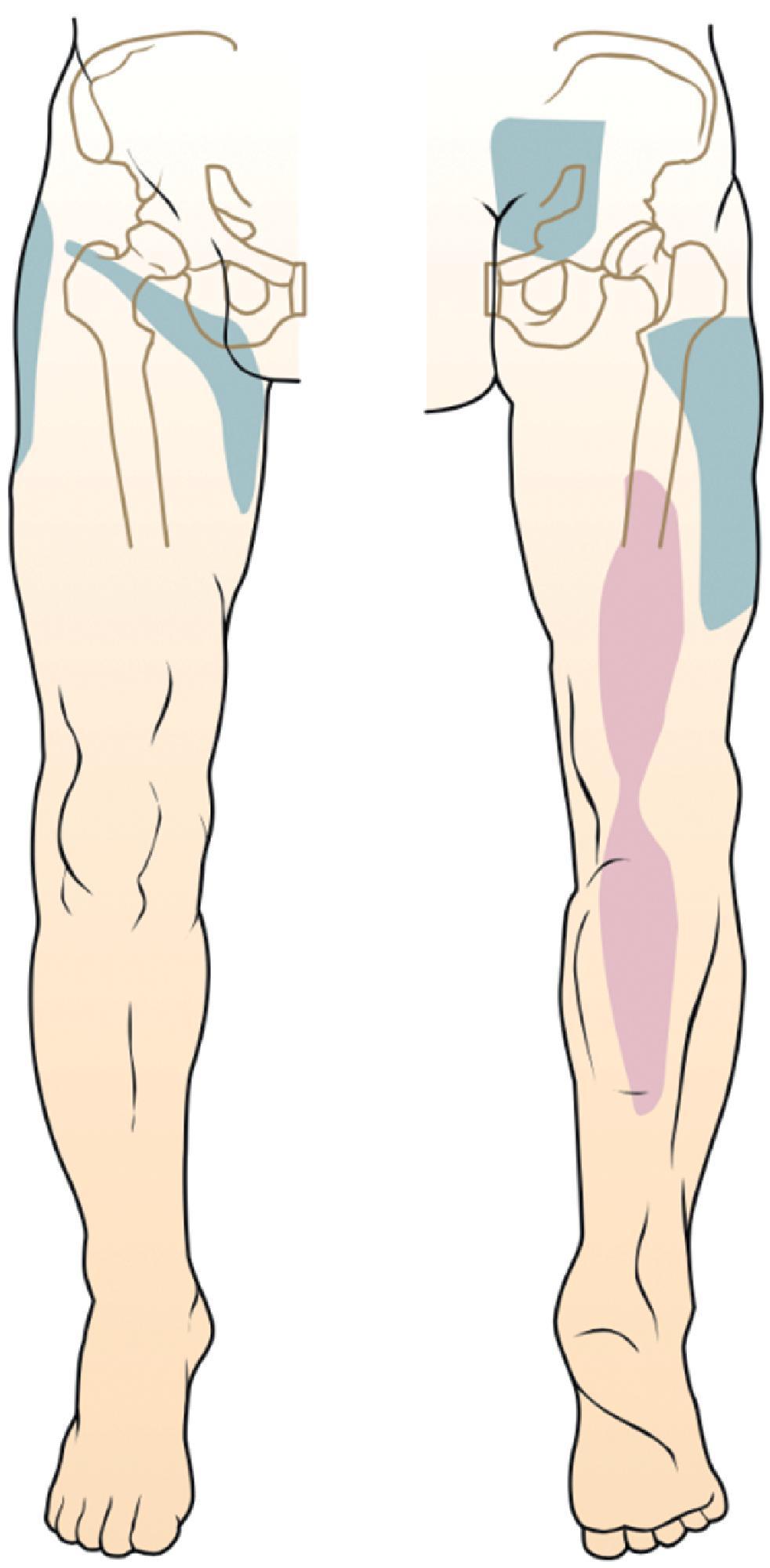
Whereas most studies examining SIJC pain referral patterns have been based on maps drawn from patients who respond to intra-articular injections or from pain patterns induced by capsular distension, some investigators have also examined pain patterns based on soft tissue SIJC injections, for example, local anesthetic injection into the dorsal ligaments. In a study of 50 patients who achieved at least 70% pain relief from extra-articular injections, the authors found that the upper ligamentous part of the SIJC generated pain near the posterior superior iliac spine with radiation to the groin, while pain emanating from the middle and lower portions of the SIJC was most prominent in the mid-and lower buttock regions, induced pain from all sections often spread into the posterolateral thigh, but infrequently below the knee. SIJC pain may also occur concurrently with other sources of LBP, with one study finding that 75% of individuals with axial LBP, herniated disc, or lumbar stenosis had radiologic evidence of SIJ arthritis.
Multiple studies have sought to evaluate the predictive value of physical examination findings in establishing the SIJ(s) as the primary pain generator using response to low-volume diagnostic blocks as the reference standard. These studies have generally found that single provocative maneuvers, alignment tests, and mobility assessments possess low sensitivity and specificity for identifying a painful SIJ. However, a systematic review that included 18 studies found that a combination of three provocative tests has sufficient discriminative power. , The maneuvers provide value in confirming the diagnosis when the symptoms suggest SI joint complex dysfunction and other causes of pain have been eliminated.
Physical examination of the patient with SIJC pain usually revealed tenderness over the posterior aspect of the joint and sacral sulcus. There were no neurologic symptoms such as numbness or weakness. There are several provocative maneuvers designed to stress the SIJC and elicit concordant pain, including the FABER (flexion, abduction, and external rotation), Patrick’s test, Gaenslen’s test, Yeoman’s (extension) test, , sacroiliac or posterior shear test, Gillet’s test, , thigh thrust test, pelvic distraction test, and pelvic compression test. Fortin’s finger test is also helpful in diagnosis, but it should probably be described as part of the history. Given the complexity of the lumbar, sacral, and pelvic anatomy, SIJC provocative maneuvers often stress structures that are in close spatial and mechanical proximity to the SIJ. This adds complexity to interpreting positive results and necessitates three positive provocative maneuvers to reasonably assure SIJC involvement in a patient’s pain.
FABER-Patrick’s test (Left SIJC exam) ( Fig. 30.2 )
Position: Supine.
Maneuver: The left leg near the ankle is placed in front of the right thigh above the knee.
The physician placed one hand over the right iliac crest while the other hand pushed over the medial aspect of the left knee.
Positive test: Pain over the left SIJ region (also back, buttock, groin)
Comment: Test stresses the SIJC and hip joint, as well as the posterior elements of the lower lumbar spine. Pain because of intra-articular hip pathology, a more common cause of groin pain, is experienced on the side with a flexed hip/knee. Pain originating in the lower lumbar spine, a more common cause of LBP, can be experienced in either laterality.
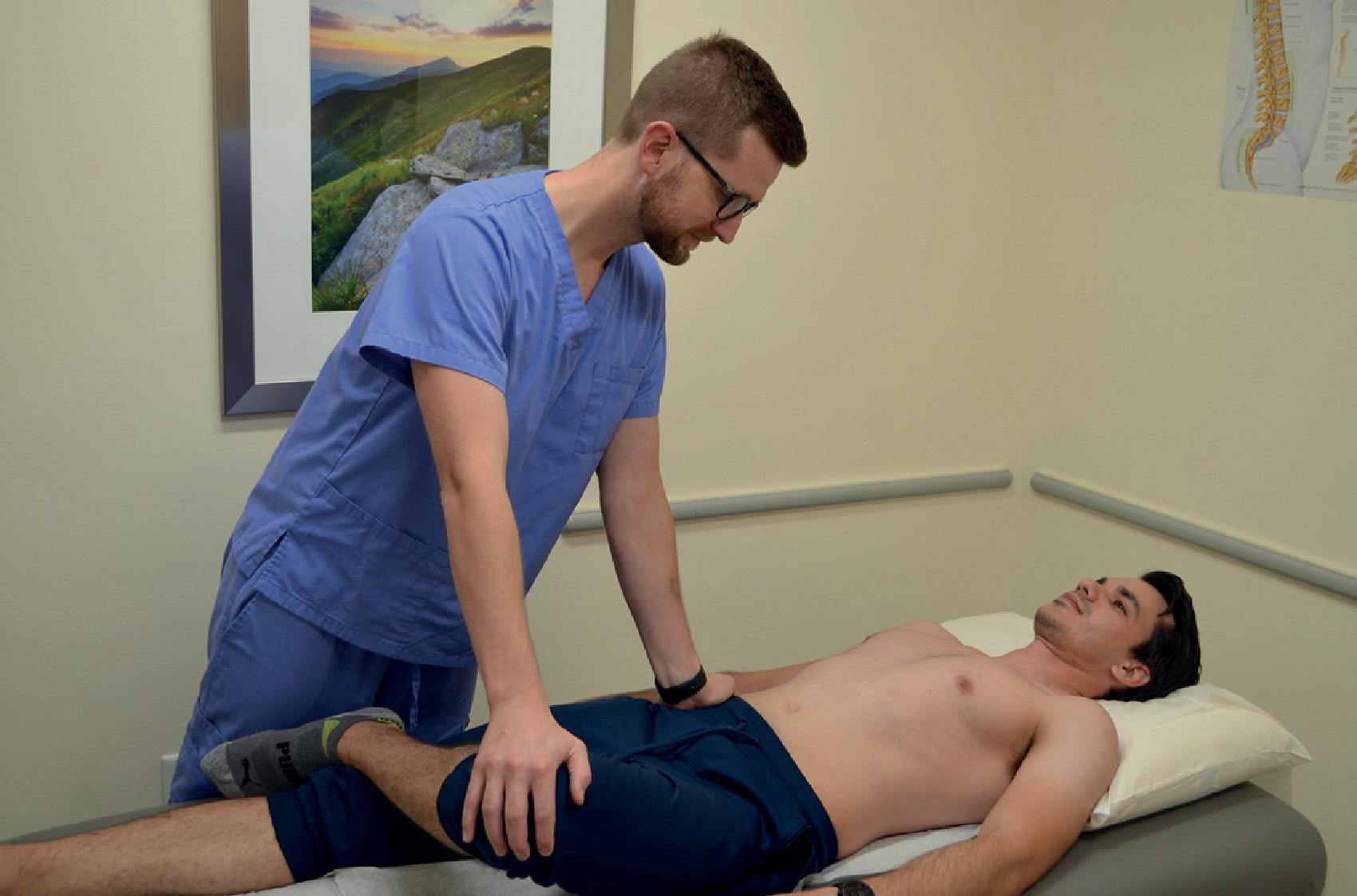
Gaenslen’s Test (Left SIJC exam) ( Fig. 30.3 )
Position: Supine. Left leg and lower thigh hanging off the examination table.
Maneuver: The examiner flexed the right hip and right knee (i.e. the hip joint was maximally flexed). The examiner presses downward over the left thigh (the hip joint is hyperextended).
Positive test: Pain in the left SIJ.
Comments: The test stresses both SIJs simultaneously by counter-rotation at the extreme range of motion of the joint. The test also stresses the hip joint and stretches the femoral nerve (the examiner should ensure the absence of hip pathology or conditions affecting the femoral nerve to diagnose SIJ syndrome).
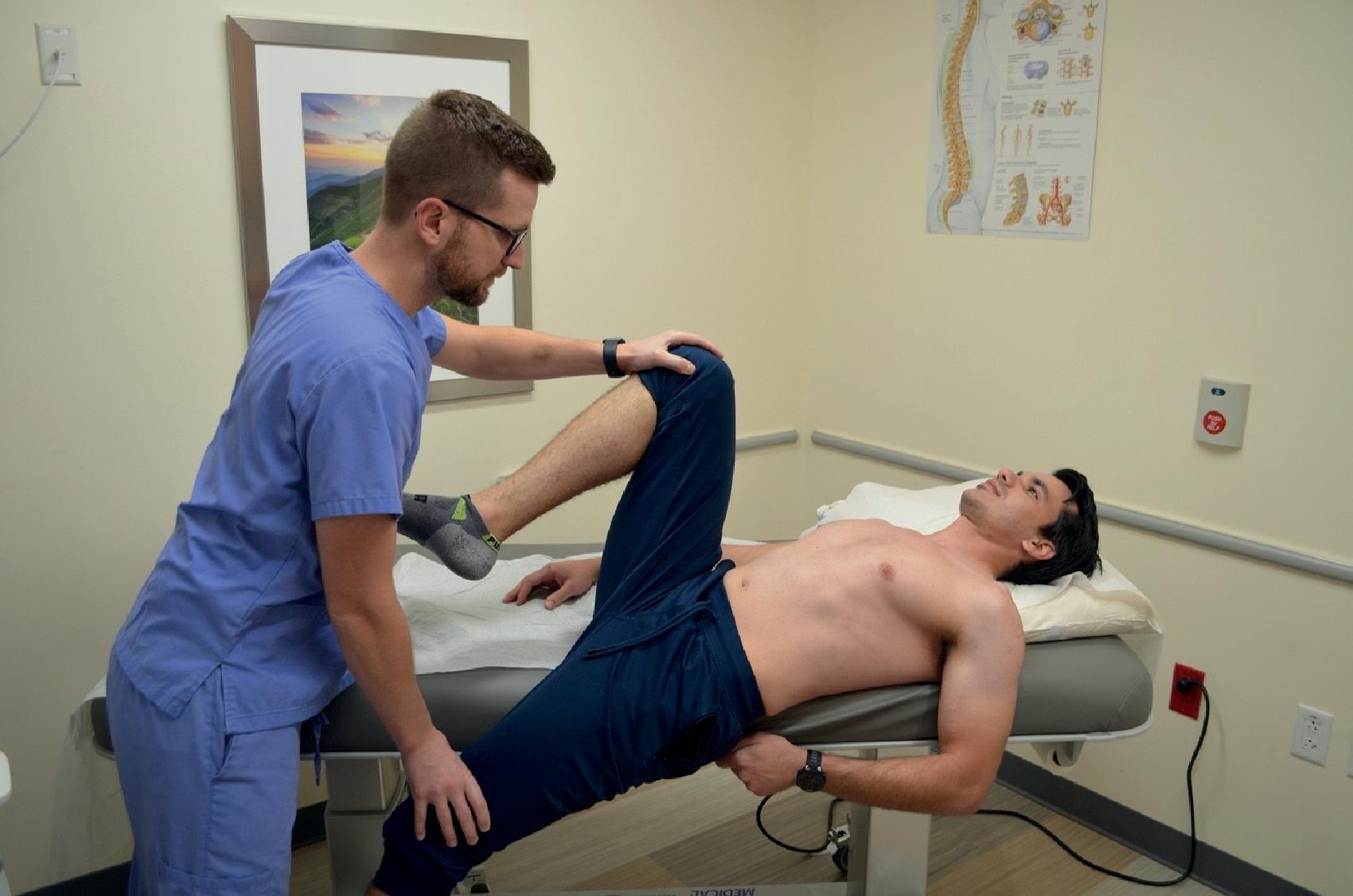
Yeoman’s Test (also called Extension Test) ( Fig. 30.4 )
Position: Prone.
Maneuver: The examiner placed one hand above the anterior aspect of the knee and elevated it slightly; the other hand pressed downward over the crest of the ilium.
Positive test: Pain over the posterior SIJ region.
Comments: The hip is extended, and the ipsilateral ilium is rotated. The test stresses the SIJ and extends the lumbar spine, and stresses the femoral nerve. It is more specific and reliable than other tests.

Gillet’s Test ( Fig. 30.5 )
Position: Standing.
Maneuver: One of the examiner’s thumbs was placed on the second sacral spinous process, and the other thumb was placed on the posterior superior iliac spine (PSIS).
Normal SIJ: The PSIS moves inferior to the S2 spinous process when the patient maximally flexes the hip.
Dysfunctional or fixed SIJ: PSIS remains at the level of the S2 spinous process or moves superior to the sacrum.
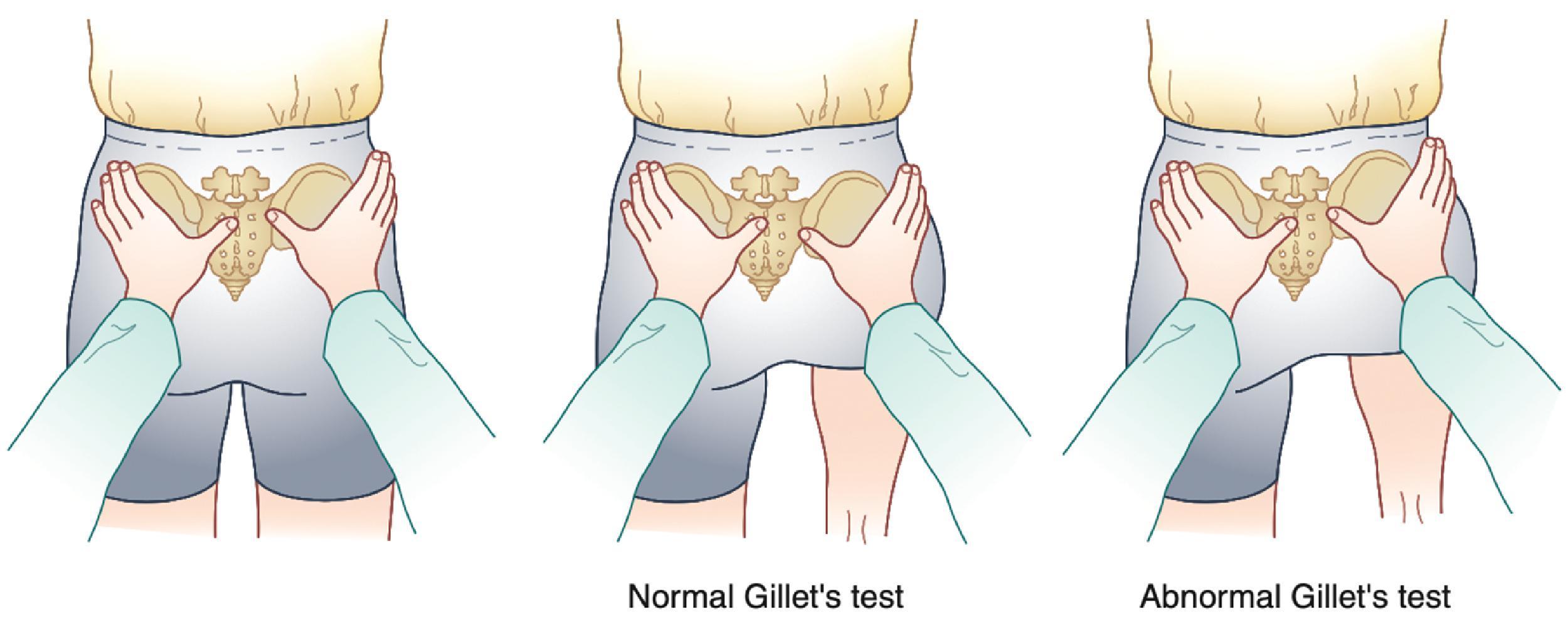
Sacroiliac Shear Test ( Fig. 30.6 )
Position: Prone.
Maneuver: The palm of the examiner’s hand was placed over the posterior iliac wing. The shear thrust is directed inferiorly, producing a shearing force across the SIJ.
Positive test: Pain in the location of the SIJC.
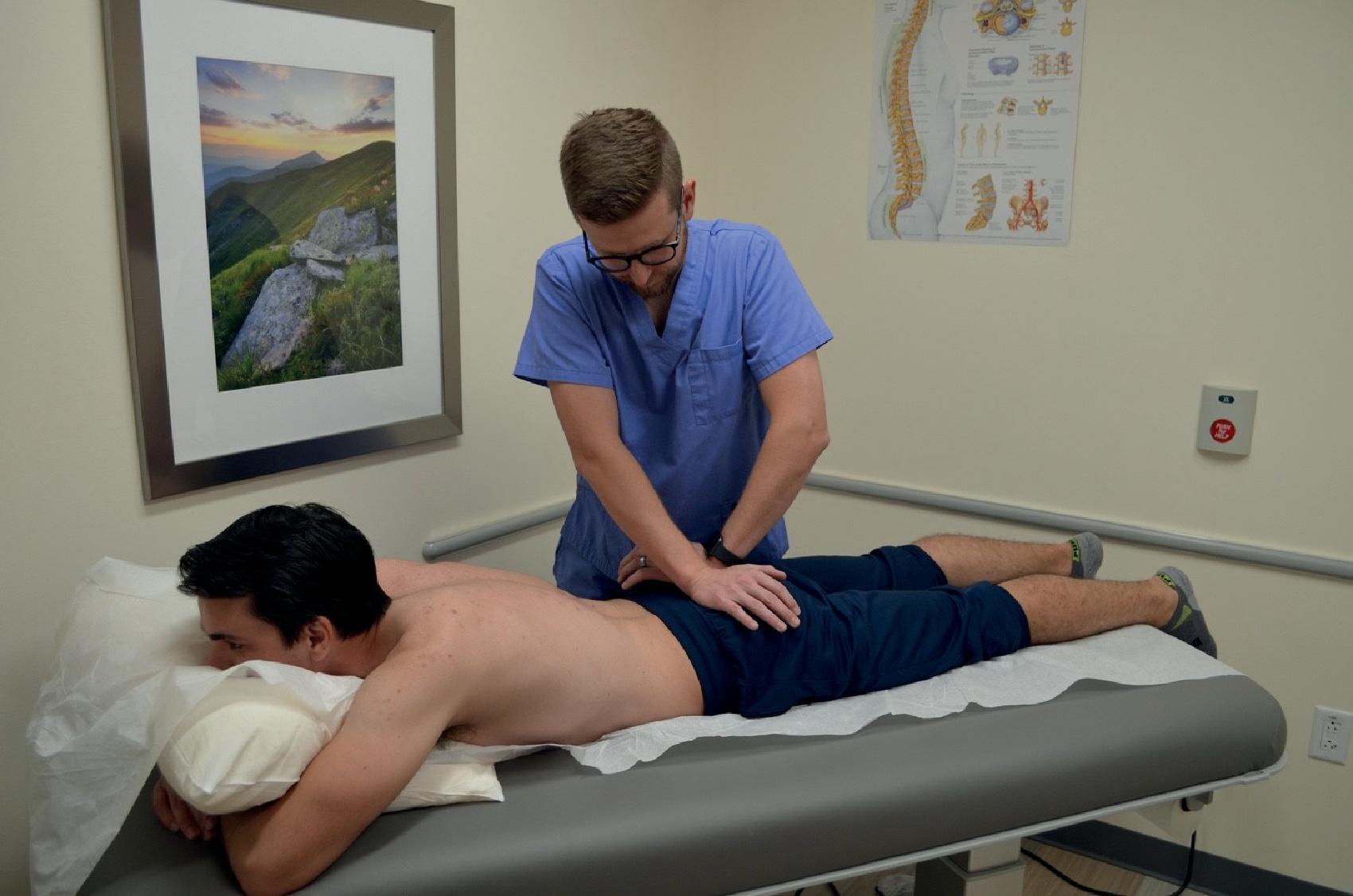
Thigh Thrust Test ( Fig. 30.7 )
Position: Prone.
Maneuver: The patient’s hip was flexed to 90°, and the knee was flexed to 90°. The practitioner positions the patient’s knee under his or her axilla and applies direct downward pressure through the femur.
Positive test: Pain over the ipsilateral SIJ region (also back, buttock, groin).
Comment: This test stresses the SIJC and hip joint as well as the posterior elements of the lower lumbar spine. Thus this examination can overlap with intra-articular hip pathology, a more common cause of groin pain, and lumbar facet joint pain, a more common cause of LBP.
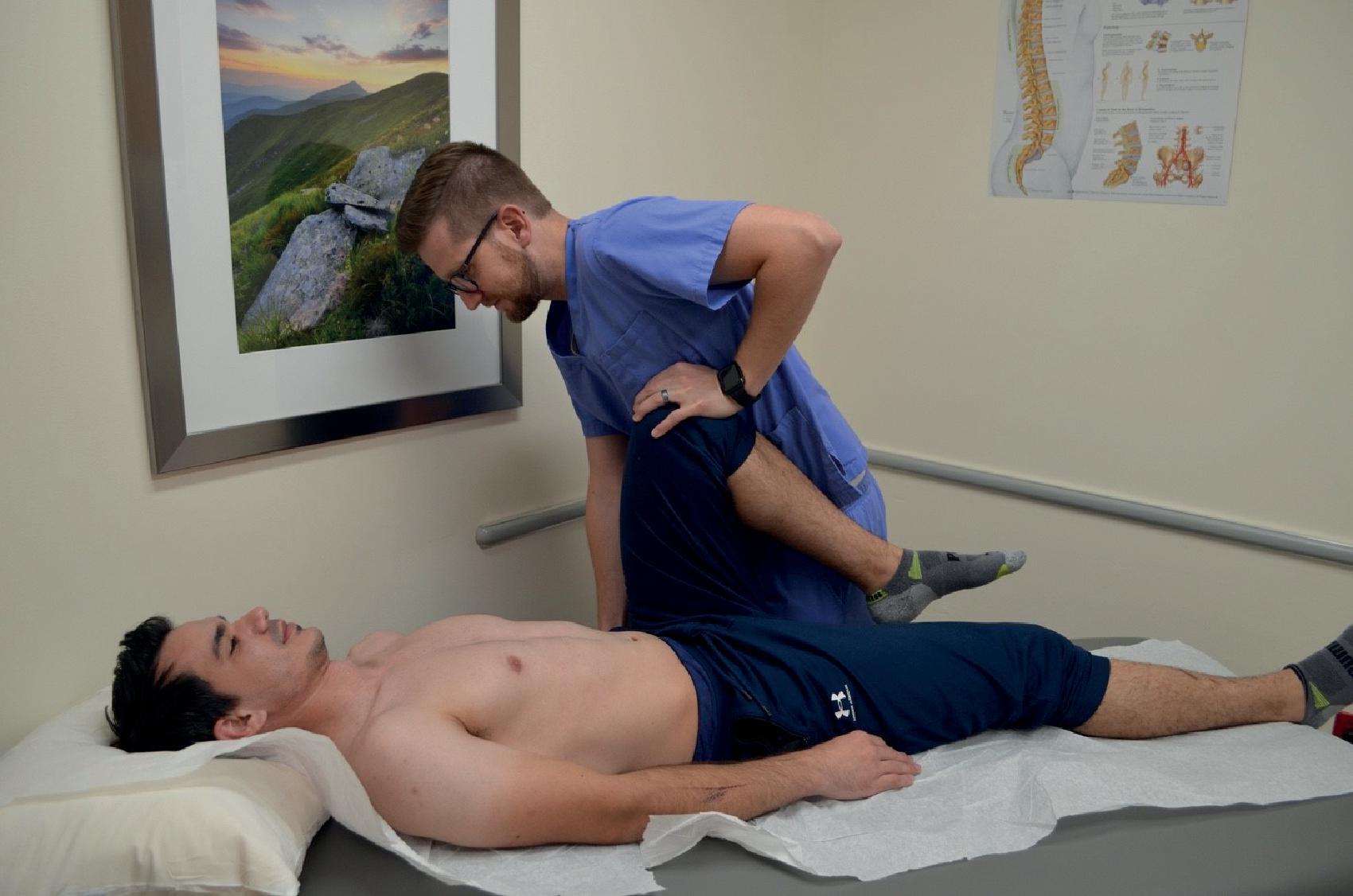
Pelvic distraction Test ( Fig. 30.8 )
Position: Prone.
Maneuver: The practitioner is facing the patient. The physician placed the left hand over the patient’s right ASIS and the right hand over the patient’s left ASIS. Firm pressure was applied outward.
Positive test: Pain over the symptomatic SIJ region (also back, buttock, groin).
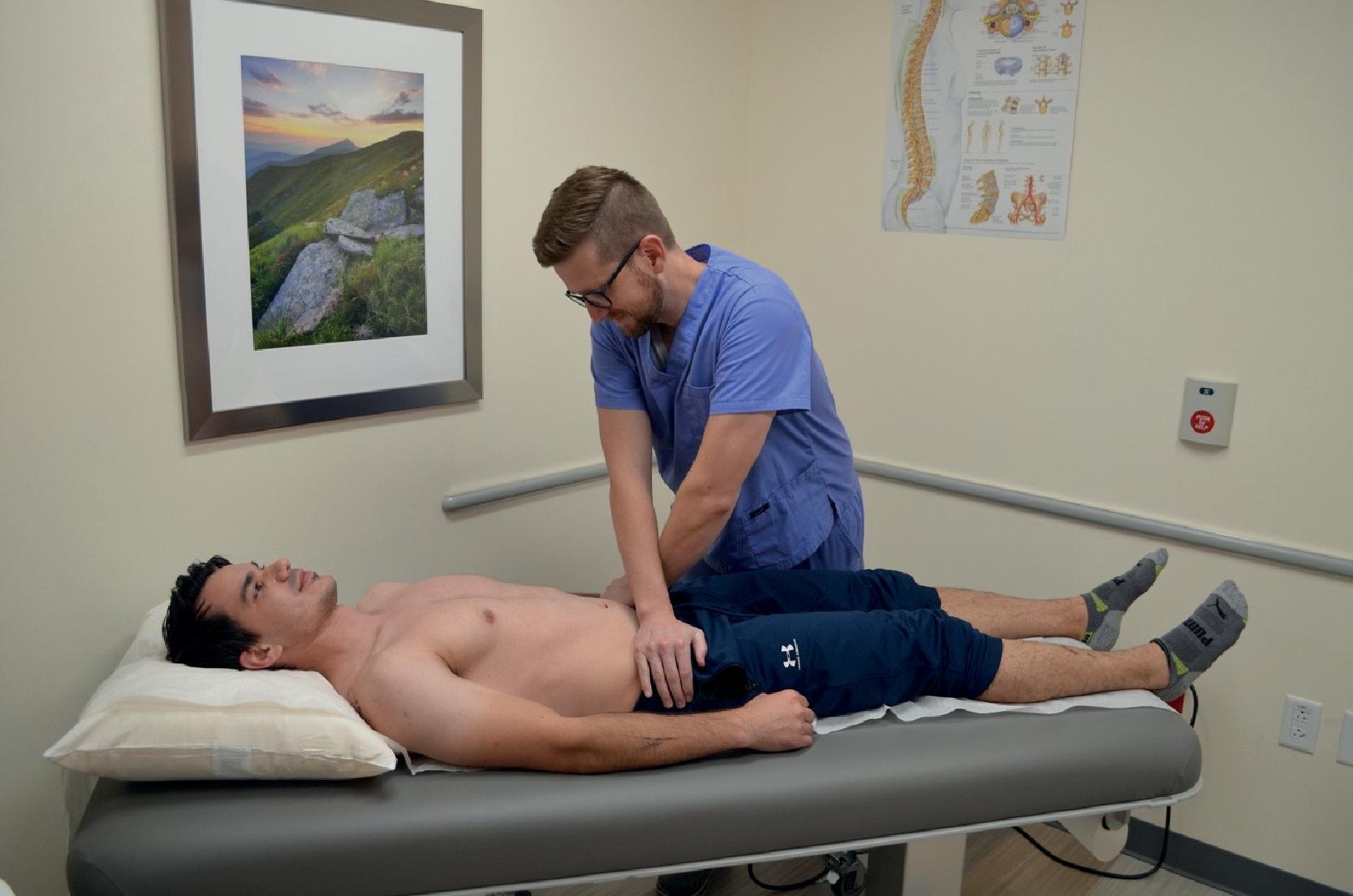
Pelvic compression Test ( Fig. 30.9 )
Position: lateral decubitus. Pelvis aligned perpendicular to the floor.
Maneuver: The practitioner is facing the patient. The practitioner places overlapping hands over the patient’s superior ASIS. The firm pressure was applied downward.
Positive test: Pain over the symptomatic SIJ region (also back, buttock, groin).
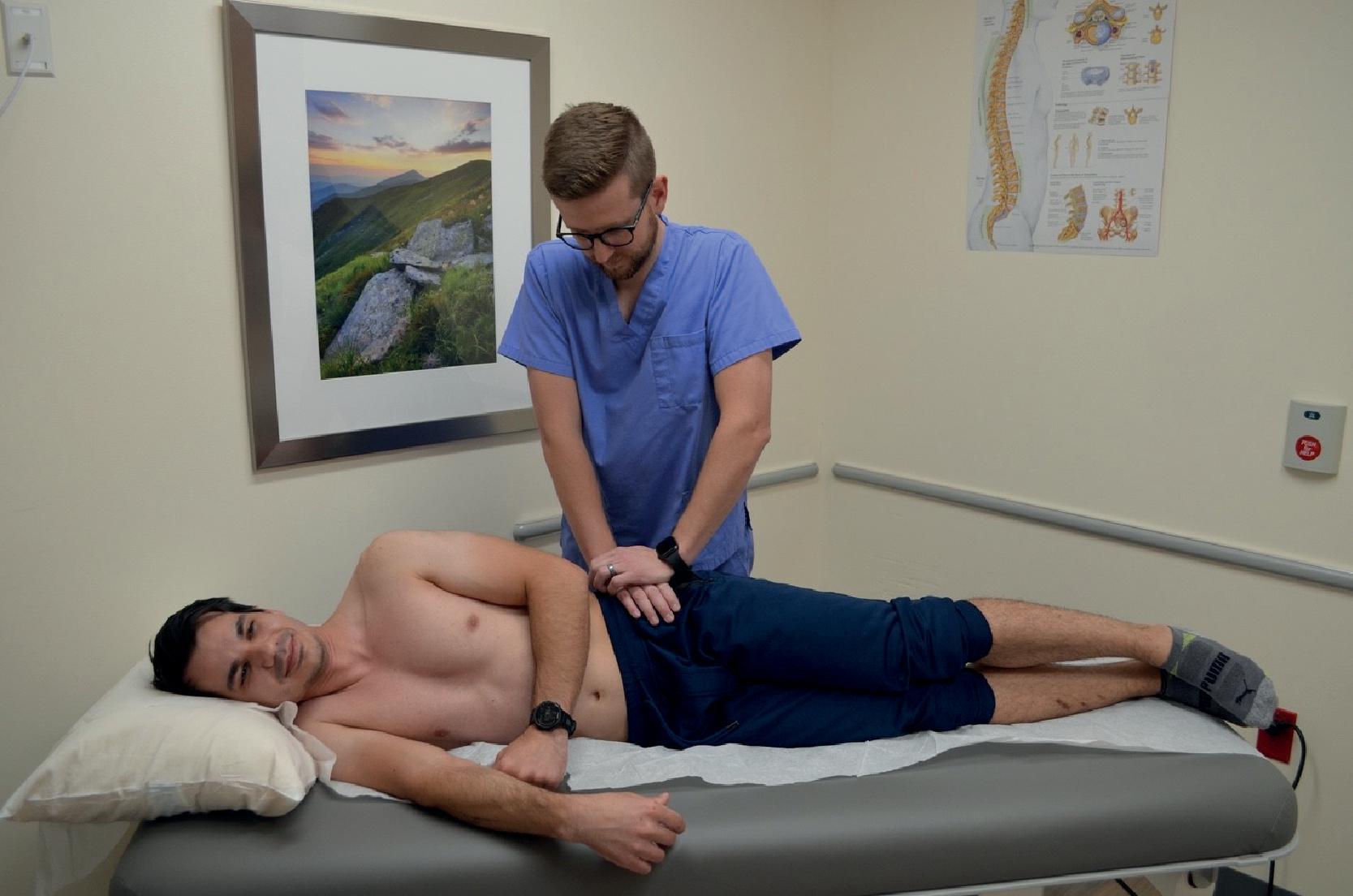
Fortin’s Finger Test ( Fig. 30.10 )
Position: Standing.
Maneuver: Patient points to their area of maximal tenderness.
Positive test: If the area of maximal tenderness is greater than the PSIS, this indicates that the SIJC is the source of pain.
Comment: Is not a part of the actual physical exam but rather the patient’s historical account.
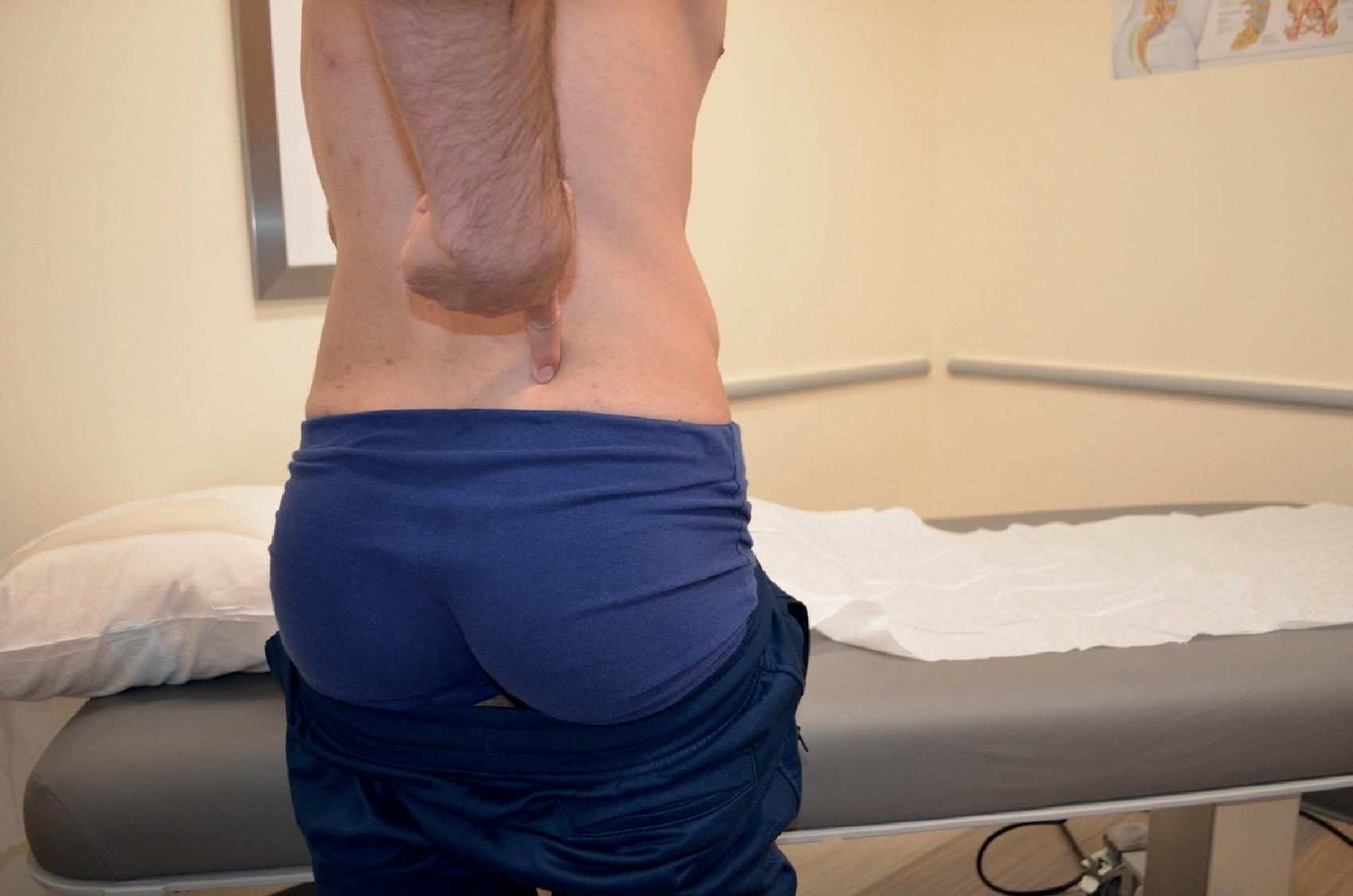
Radiographic evaluation of the joint rarely aids diagnosis other than in the setting of trauma or an underlying rheumatologic condition such as spondyloarthropathy (e.g. ankylosing spondylitis). However, using fluoroscopy to assess whether Fortin’s point truly overlies the SIJ space has higher sensitivity than physical examination maneuvers alone. X-ray and computed tomography (CT) can show changes to the joint space, bone erosions, subchondral sclerosis, and bony malalignment. Magnetic resonance imaging (MRI) can show intra-articular fluid signal, soft tissue and bone edema, fatty infiltration, and joint erosions, while bone scan can show active areas of increased metabolic uptake. CT has low sensitivity and specificity, and radionucleotide bone scans have low sensitivity but high specificity in patients with positive diagnostic blocks. To date, there have been no studies showing an association between x-ray or MRI findings and pain of the SIJC using a reference standard such as a diagnostic injection, but in patients with inflammatory spondyloarthropathies, there is an association between SIJ pathology on MRI, buttock pain, and positive response to nonsteroidal anti-inflammatory drugs (NSAIDs). Diagnostic local anesthetic block of the joint is considered the standard criterion for SI joint pain, although complex innervation patterns and technical limitations prevent it from being considered a gold standard. , , Provocation of pain on injection of the SIJ alone is not a suitable criterion for the diagnosis of SIJC as the putative source of buttock pain.
In individuals with correctable pathology, such as leg length discrepancy, malalignment, or muscle weakness, addressing the underlying etiology with guided exercise, manual therapy including manipulation, or shoe lifts may be beneficial, and there is some evidence supporting medications such as anti-depressants, NSAIDs, and opioids for short-term benefit. However, none have been specifically studied in individuals with SIJC pathology.
Only a handful of prospective studies have evaluated the efficacy of steroid injections for SIJC pain. These studies have shown benefits for both intra- and extra-articular injections, , but all have been characterized by short-term follow up (≤2 months) and small numbers (<25 patients). Studies that have compared intra- and extra-articular injections have yielded mixed findings, suggesting that the injection location should be targeted toward the suspected pain generators (i.e. into the ligaments in young people with suspected extra-articular pathology vs. between the bony interface in older people with arthritis). In individuals with injection-confirmed SIJ pain who fail to derive intermediate- or long-term benefits, placebo-controlled and observational studies indicate that SLBN RFA may provide benefits lasting between six months and one year. Since the lateral branches targeted by RFA innervate the posterior ligaments but not the joint capsule, individuals with extra-articular pathology may be more likely to benefit. This is supported by a study evaluating SLBN RFA outcome predictors whereby older individuals, who are more likely to suffer from arthritis, were more prone to fail treatment.
Arthrodesis has been used for decades to treat SIJC pain resulting from fractures, instability/dislocations, and secondary to degenerative changes. Among these indications, SI joint arthropathy is one of the most controversial, with the available studies being confounded by poor selection criteria, diverse outcome measures, and various forms of bias. Recently, there has been a surge in the use of minimally invasive SIJ fusion techniques to treat individuals who have failed conservative management, with results from observational and prospective randomized trials showing benefits for up to two years.
For diagnostic injections, patients were asked to stop their pain medication on the day of the procedure. Sedation is not recommended by the American Society of Anesthesiologists or Spine Intervention Society and has been shown in a large, randomized crossover study to increase the false-positive rate of diagnostic SIJ injections. Light sedation (low dose intravenous or oral benzodiazepine) may be administered to anxious patients or those with a history of vasovagal episodes. Contraindications to the injection include infection in the area and bleeding diathesis. Allergy (not anaphylaxis) to contrast media may require pretreatment with antihistamines and steroids, whereas allergy to local anesthetics may require identification of the appropriate local anesthetic to be used for the procedure. The use of imaging is recommended during SIJ injection to ensure intra-articular needle placement, as blind injections rarely result in correct needle positioning and may increase the risk of complications. , ,
Fluoroscopy is considered the standard of care for intra-articular SIJ injection, as it detects both intra-vascular and intra-articular needle placement. However, this image guidance modality does not guarantee successful joint access. Therefore more challenging anatomy may require CT guidance. ,
The technique for SIJ injection has been described. , The target point typically lies along the inferoposterior aspect of the joint, in the area 1 to 2 cm cephalad from its most caudal end. Although in individuals with suspected extra-articular pathology, the most painful area may be targeted, such as the cephalad portion of the dorsal ligaments.
Once the needle was within the joint, a small amount of contrast was injected to demonstrate intra-articular spread ( Fig. 30.11 ). The response of the patient to the injection of contrast media is noted as either “no pain,” “unfamiliar pain,” or “similar pain” than the pain complaint. After appropriate contrast spread, a solution of steroid and local anesthetic is injected. Because the capacity of the SIJ is small and distension may exacerbate pain or rupture the joint capsule, a maximum volume of 2 to 3 mL has been recommended for intra-articular SIJ injections. , Spillage of injectate outside the SIJ is acceptable because some of the pain receptors are located outside the joint. Some practitioners advocate specifically for intra-articular and extra-articular injectate placement because of the known innervation throughout the SIJC, as described above.
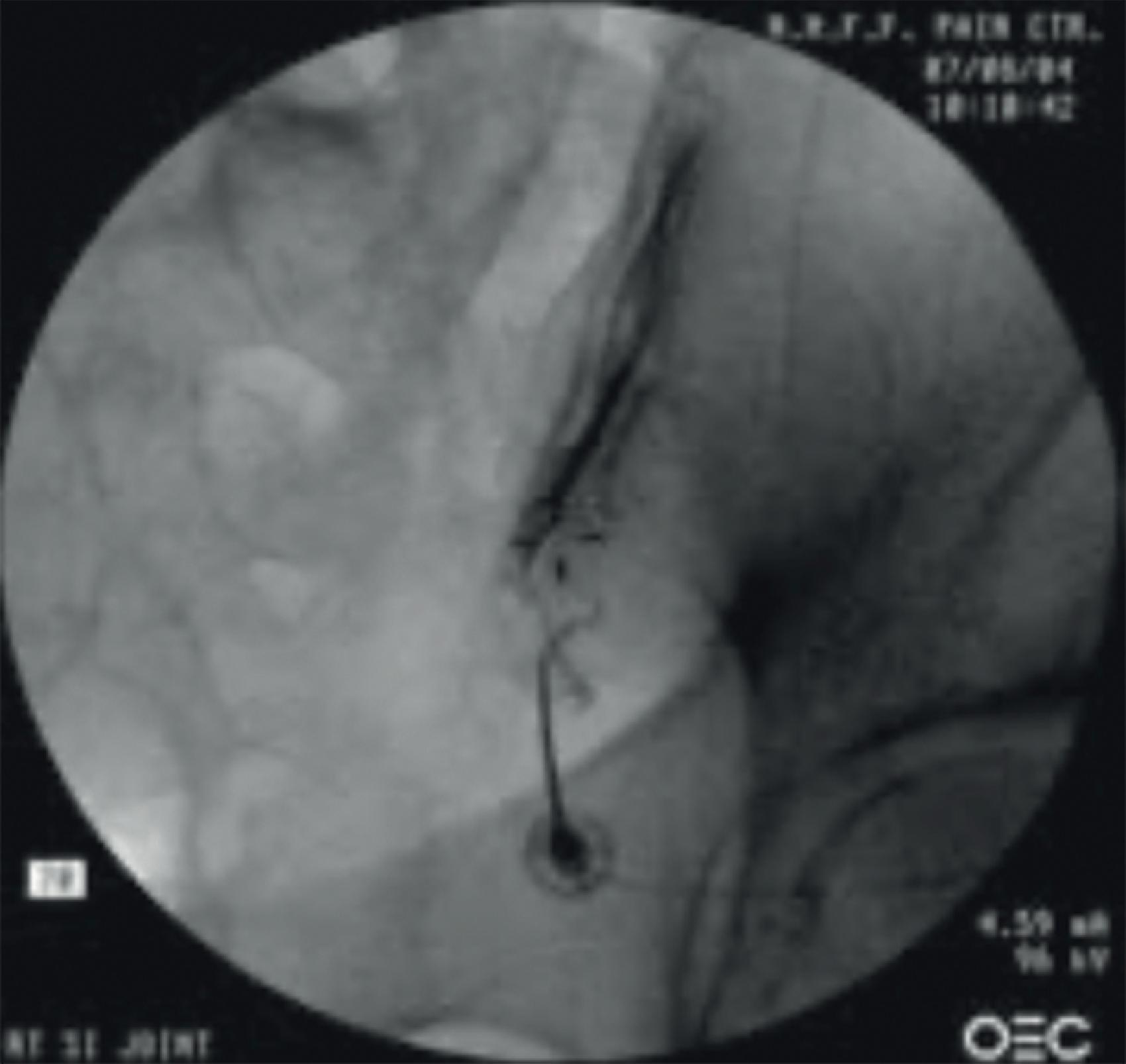
Other approaches include placement of the needle at the inferior end where the posterior and anterior joints overlap if a markedly lucent zone is noted in that area. The midportion of the joint can also be cannulated, although the joint capsule typically extends only about one-third of the way up from the caudad border. Finally, the superior aspect of the joint can be accessed using a cephalo-caudad approach.
After the procedure, the patient should be observed for 15 to 30 min to determine the analgesic response and monitor for complications. The local anesthetic has an immediate effect, but the anti-inflammatory effect of depo-steroid develops over 2 to 5 days, sooner for non-particulate formulations. Guidelines vary regarding the cutoff for designating a block as positive, with some using ≥75% pain relief, others using ≥50%, and still, others advocate an even lower cutoff as the United States Food and Drug Administration and IMMPACT guidelines consider ≥30% pain relief to be a clinically meaningful response. , Because SI joint pain typically coexists with other musculoskeletal conditions and there is no reliable alternative to treatment, using a less stringent cutoff, such as 50%, as advocated by the international facet guidelines for diagnostic injections, will maximize access to care. Provocative maneuvers can be repeated to assess the improvement. Transient weakness in the ipsilateral leg is because of the spillage of the local anesthetic onto the sacral nerve roots or the SN. Other complications include bleeding, infection, exacerbation of pain, fever, transient difficulty voiding, and allergic reactions to components of the prep solution or injectate.
The feasibility of ultrasound-guided SI joint injections was initially shown by Pekkafahli et al. and was further described by Harmon and O’Sullivan. A curvilinear low-frequency transducer (4 to 6 MHz) was placed perpendicular to the skin over the distal sacrum in the midline in a cross-sectional view (short axis) to identify the sacral hiatus. The probe was moved laterally until the lateral edge of the sacrum came in view and then moved the cephalad to find the medial aspect of the iliac bone. At this site, the SIJ appeared as a hypoechoic wedge-shaped structure ( Fig. 30.12 ). The target area for injection was at the level of the second sacral foramen, which was approximately 2 to 3 cm above the caudal pole of the SI joint. A 22 gauge needle was inserted and advanced in-plane with a lateral and anterior trajectory into the joint. Pop is felt once the synovial joint penetrates. The visible spread of injectate outside the joint indicates periarticular rather than intra-articular placement.
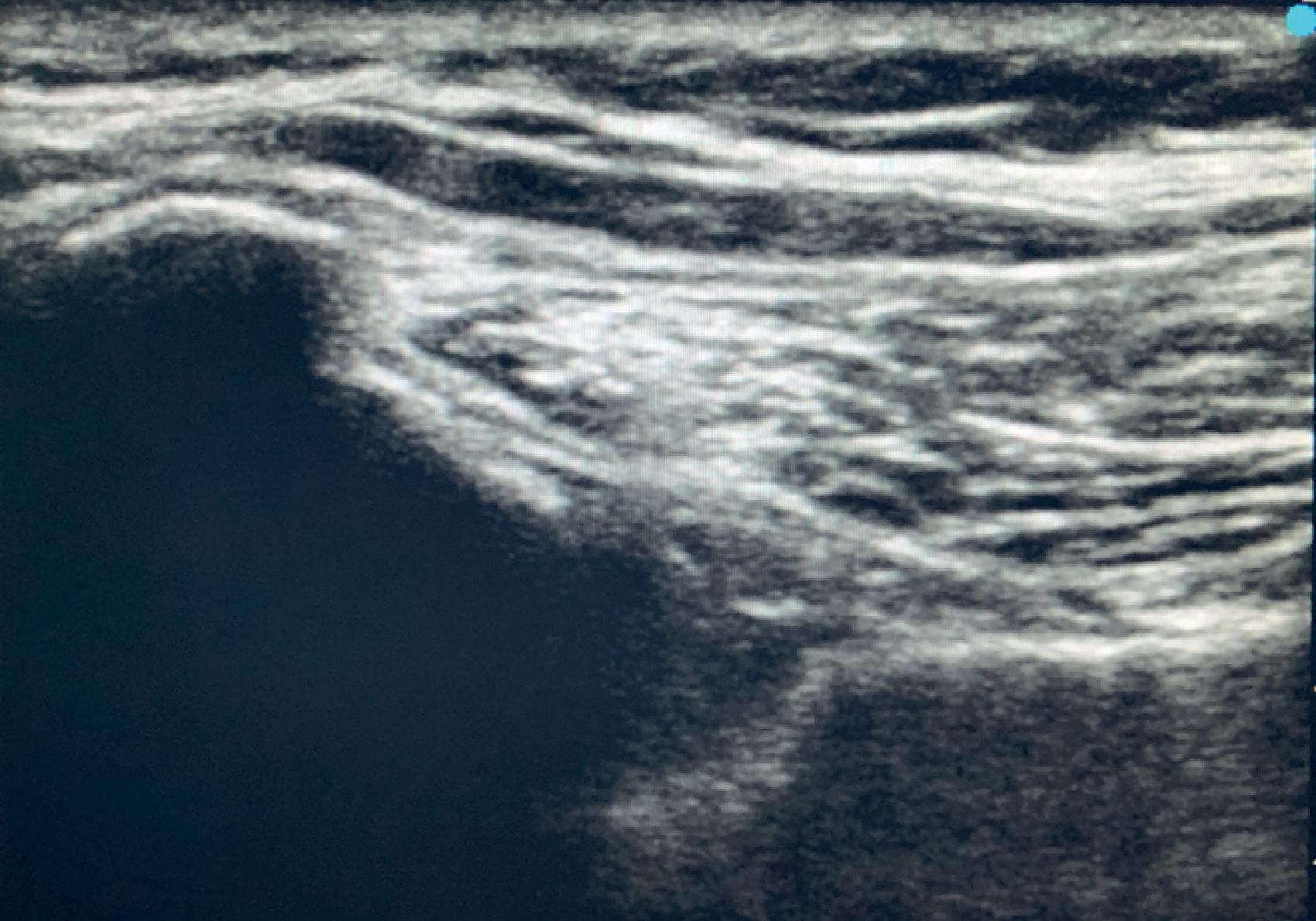
The accuracy of this technique was also assessed. Klauser et al. evaluated ultrasound-guided SIJ injection in cadavers at two levels of the joint by comparing approaches at the level of the first sacral foramen versus those at the second sacral foramen. CT examination showed 90% of the needles at the lower level to be within the SIJ versus 70% at the upper level. The same procedure resulted in an intra-articular placement rate of 100% in both locations (eight in the lower and two in the upper site) when performed in live patients. Jee and colleagues showed an improved ability to avoid intra-vascular structures but a lower intra-articular accuracy rate (87%) with ultrasound versus fluoroscopy (98%). De Luigi et al. found 48/50 (98%) of ultrasound injections to be intra-articular with fluoroscopic confirmation, while Perry et al. found 15/17 (88%) to be intra-articular based on cadaveric dissections. Successful ultrasound injection may be largely related to factors such as body habitus and practitioner experience; for example, Pekkafahli et al. noted marked improvement with operator experience, from a 60% success rate in their first 30 injections to a 94% success rate in their second 30 injections. The successful placement of ultrasound-guided SIJ injections has not been universal. One cadaveric study by Stelzer et al. showed a significantly higher rate of intra-articular injections with fluoroscopy versus ultrasound.
Injection of the SIJ has been described under CT guidance. Success rates from CT-guided injections range from 75% to 92% in the literature. , The increased radiation exposure and lack of availability of CT in pain clinics restrict the wider application of this approach.
Palpation-guided intra-articular injections have been shown to be extra-articular in most cases, with one study finding that contrast spread was more likely to be epidural than intra-articular. , , In three studies that examined the accuracy of landmark-guided injections, the range for intra-articular spread was between 8% and 22%. , , Yet, landmark-guided injections have been reported to result in good pain relief in uncontrolled studies. In a large, randomized, double-blind study by Cohen et al., landmark-guided injections were associated with comparable benefits to fluoroscopically guided injections at one month. However, three months intra-articular injections at three months were superior in some outcome measures. However, some complications were more frequent in the landmark-guided group, and the generally positive results might not be generalizable to a primary care provider population. Palpation guidance cannot be recommended for diagnostic purposes and should not be routinely utilized for therapeutic purposes.
Become a Clinical Tree membership for Full access and enjoy Unlimited articles
If you are a member. Log in here